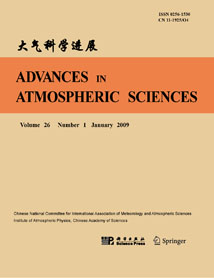| [1] |
Ding Yuguo, Tu Qipu, Wen Min,
1995: A Statistical Model for Investigating Climatic Trend Turning Points, ADVANCES IN ATMOSPHERIC SCIENCES, 12, 47-56.
doi: 10.1007/BF02661286
|
| [2] |
SUN Guodong, MU Mu,
2011: Response of a Grassland Ecosystem to Climate Change in a Theoretical Model, ADVANCES IN ATMOSPHERIC SCIENCES, 28, 1266-1278.
doi: 10.1007/s00376-011-0169-6
|
| [3] |
CHOU Jieming, DONG Wenjie, FENG Guolin,
2010: Application of an Economy--Climate Model to Assess the Impact of Climate Change, ADVANCES IN ATMOSPHERIC SCIENCES, 27, 957-965.
doi: 10.1007/s00376-009-8166-8
|
| [4] |
REN Guoyu, DING Yihui, ZHAO Zongci, ZHENG Jingyun, WU Tongwen, TANG Guoli, XU Ying,
2012: Recent Progress in Studies of Climate Change in China, ADVANCES IN ATMOSPHERIC SCIENCES, 29, 958-977.
doi: 10.1007/s00376-012-1200-2
|
| [5] |
Jeong-Hyeong LEE, Byungsoo KIM, Keon-Tae SOHN, Won-Tae KOWN, Seung-Ki MIN,
2005: Climate Change Signal Analysis for Northeast Asian Surface Temperature, ADVANCES IN ATMOSPHERIC SCIENCES, 22, 159-171.
doi: 10.1007/BF02918506
|
| [6] |
Zhao Ming, Zeng Xinmin,
2002: A Theoretical Analysis on the Local Climate Change Induced by the Change of Landuse, ADVANCES IN ATMOSPHERIC SCIENCES, 19, 45-63.
doi: 10.1007/s00376-002-0033-9
|
| [7] |
ZHANG Wen, HUANG Yao, SUN Wenjuan, YU Yongqiang,
2007: Simulating Crop Net Primary Production in China from 2000 to 2050 by Linking the Crop-C model with a FGOALS's Model Climate Change Scenario, ADVANCES IN ATMOSPHERIC SCIENCES, 24, 845-854.
doi: 10.1007/s00376-007-0845-8
|
| [8] |
BUHE Cholaw, Ulrich CUBASCH, LIN Yonghui, JI Liren,
2003: The Change of North China Climate in Transient Simulations Using the IPCC SRES A2 and B2 Scenarios with a Coupled Atmosphere-Ocean General Circulation Model, ADVANCES IN ATMOSPHERIC SCIENCES, 20, 755-766.
doi: 10.1007/BF02915400
|
| [9] |
HAN Zuoqiang, YAN Zhongwei*, LI Zhen, LIU Weidong, and WANG Yingchun,
2014: Impact of Urbanization on Low-Temperature Precipitation in Beijing during 19602008, ADVANCES IN ATMOSPHERIC SCIENCES, 31, 48-56.
doi: 10.1007/s00376-013-2211-3
|
| [10] |
ZHANG Lixia* and ZHOU Tianjun, ,
2014: An Assessment of Improvements in Global Monsoon Precipitation Simulation in FGOALS-s2, ADVANCES IN ATMOSPHERIC SCIENCES, 31, 165-178.
doi: 10.1007/s00376-013-2164-6
|
| [11] |
Vladimir A. Lobanov,
2001: Empirical-Statistical Methodology and Methods for Modeling and Forecasting of Climate Variability of Different Temporal Scales, ADVANCES IN ATMOSPHERIC SCIENCES, 18, 844-863.
|
| [12] |
Bo HAN, Shihua LÜ, Ruiqing LI, Xin WANG, Lin ZHAO, Cailing ZHAO, Danyun WANG, Xianhong MENG,
2017: Global Land Surface Climate Analysis Based on the Calculation of a Modified Bowen Ratio, ADVANCES IN ATMOSPHERIC SCIENCES, 34, 663-678.
doi: 10.1007/s00376-016-6175-y
|
| [13] |
LI Zhen, YAN Zhongwei,
2010: Application of Multiple Analysis of Series for Homogenization to Beijing Daily Temperature Series (1960--2006), ADVANCES IN ATMOSPHERIC SCIENCES, 27, 777-787.
doi: 10.1007/s00376-009-9052-0
|
| [14] |
Ge Ling, Liang Jiaxing, Chen Yiliang,
1996: Spatial / Temporal Features of Antarctic Climate Change, ADVANCES IN ATMOSPHERIC SCIENCES, 13, 375-382.
doi: 10.1007/BF02656854
|
| [15] |
Dai Xiaosu, Ding Yihui,
1994: A Modeling Study of Climate Change and Its Implication for Agriculture in China Part II: The Implication of Climate Change for Agriculture in China, ADVANCES IN ATMOSPHERIC SCIENCES, 11, 499-506.
doi: 10.1007/BF02658171
|
| [16] |
Gao Ge, Huang Chaoying,
2001: Climate Change and Its Impact on Water Resources in North China, ADVANCES IN ATMOSPHERIC SCIENCES, 18, 718-732.
doi: 10.1007/BF03403497
|
| [17] |
JI Mingxia, HUANG Jianping, XIE Yongkun, LIU Jun,
2015: Comparison of Dryland Climate Change in Observations and CMIP5 Simulations, ADVANCES IN ATMOSPHERIC SCIENCES, 32, 1565-1574.
doi: 10.1007/s00376-015-4267-8
|
| [18] |
Chong-yu XU, Elin WIDN, Sven HALLDIN,
2005: Modelling Hydrological Consequences of Climate Change-Progress and Challenges, ADVANCES IN ATMOSPHERIC SCIENCES, 22, 789-797.
doi: 10.1007/BF02918679
|
| [19] |
BAI Jie, GE Quansheng, DAI Junhu,
2011: The Response of First Flowering Dates to Abrupt Climate Change in Beijing, ADVANCES IN ATMOSPHERIC SCIENCES, 28, 564-572.
doi: 10.1007/s00376-010-9219-8
|
| [20] |
DING Yihui, REN Guoyu, ZHAO Zongci, XU Ying, LUO Yong, LI Qiaoping, ZHANG Jin,
2007: Detection, Causes and Projection of Climate Change over China: An Overview of Recent Progress, ADVANCES IN ATMOSPHERIC SCIENCES, 24, 954-971.
doi: 10.1007/s00376-007-0954-4
|















 AAS Website
AAS Website 
 AAS WeChat
AAS WeChat 
 DownLoad:
DownLoad: